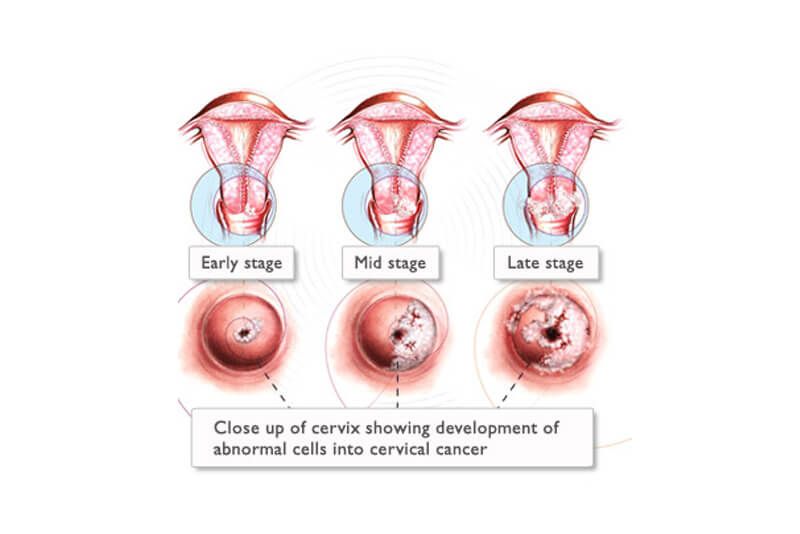Signs and Symptoms of Cervical Cancer
Women with early cervical cancers and pre-cancers usually have no symptoms. Symptoms often do not begin until the cancer becomes invasive and grows into nearby tissue. When this happens, the most common symptoms are:
- Abnormal vaginal bleeding, such as bleeding after vaginal sex, bleeding after menopause, bleeding and spotting between periods, and having (menstrual) periods that are longer or heavier than usual. Bleeding after douching or after a pelvic exam may also occur.
- An unusual discharge from the vagina − the discharge may contain some blood and may occur between your periods or after menopause.
- Pain during sex.
These signs and symptoms can also be caused by conditions other than cervical cancer. For example, an infection can cause pain or bleeding. Still, if you have any of these symptoms, see a health care professional right away. Ignoring symptoms may allow the cancer to grow to a more advanced stage and lower your chance for effective treatment.
Survival Rates for Cervical Cancer, by Stage
Survival rates tell you what percentage of people with the same type and stage of cancer are still alive a certain amount of time (usually 5 years) after they were diagnosed. They can’t tell you how long you will live, but they may help give you a better understanding about how likely it is that your treatment will be successful. Some people will want to know the survival rates for their cancer, and some people won’t. If you don’t want to know, you don’t have to.
What is a 5-year survival rate?
Statistics on the outlook for a certain type of cancer are often given as 5-year survival rates. The 5-year survival rate is the percentage of people who live at least 5 years after being diagnosed with cancer. For example, a 5-year survival rate of 70% means that an estimated 70 out of 100 people who have that cancer are still alive 5 years after being diagnosed. Keep in mind, however, that many of these people live much longer than 5 years after diagnosis.
But remember, all survival rates are estimates – your outlook can vary based on a number of factors specific to you.
Cancer survival rates don’t tell the whole story
Survival rates are often based on previous outcomes of large numbers of people who had the disease, but they can’t predict what will happen in any particular person’s case. There are a number of limitations to remember:
- The numbers below are among the most current available. But to get 5-year survival rates, doctors have to look at people who were treated at least 5 years ago. As treatments are improving over time, women who are now being diagnosed with cervical cancer may have a better outlook than these statistics show.
- These statistics are based on when the cancer was first diagnosed. They do not apply to cancers that later come back or spread, for example.
- The outlook for women with cervical cancer varies by the stage (extent) of the cancer – in general, the survival rates are higher for women with earlier stage cancers. But other factors can also affect a woman’s outlook, such as her age and overall health, and how well the cancer responds to treatment. The outlook for each woman is specific to her circumstances.
Survival rates for cervical cancer
The rates below were published in 2010 in the 7th edition of the AJCC staging manual. They are based on data collected by the National Cancer Data Base from people diagnosed between 2000 and 2002. These are the most recent statistics available for survival by the current staging system.
- The 5-year survival rate for people with stage 0 cervical cancer is about 93%.
- For stage IA cervical cancer, the 5-year survival rate is about 93% For stage IB cancer, the 5-year survival rate is about 80%.
- For stage IIA cervical cancer, the 5-year survival rate is about 63%. For stage IIB cancer, the 5-year survival rate is about 58%.
- The 5-year survival rate for stage IIIA cervical cancer is about 35%. For stage IIIB cancer, the 5-year survival rate is about 32%
- Stage IVA cervical cancer has a 5-year survival rate of about 16%, and stage IVB cancer has a 5-year survival rate of about 15%. Still, there are often treatment options available for women with these stages of cancer.
Remember, these survival rates are only estimates – they can’t predict what will happen to any individual person. We understand that these statistics can be confusing and may lead you to have more questions. Talk to your doctor to better understand your specific situation.


